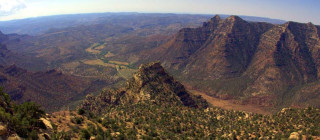Range Creek Geography & Geology

The Range Creek ecosystem is the area of the West Tavaputs Plateau drained by Range Creek, a perennial stream that flows about thirty miles in a roughly northwest to southeast direction to its confluence with the Green River. The creek originates at Bruin Point about 10,200 feet above sea level and terminates thirty miles south at an elevation of about 4,200 feet at the confluence. Local topography consists of friable sandstones, mostly lacustrine deposits attributed to the Tertiary Period of geologic history, with a south-to-north tilt characterized by dramatically deep erosionally carved canyons that ultimately drain into the Green River.
Physiographically the project area is situated in the Book Cliff-Roan Plateau section of the Colorado Plateau Provenience. The nearly vertical Book Cliffs are carved into Cretaceous (145-65 MYA) sandstones and shales of marine origin. The Roan Cliffs found to the north and at higher elevations, are composed of river and flood plain deposits of Paleocene (55-65 MYA) and Eocene (34-55 MYA) origin. The fossilized shells and reptile bones found in these formations attest that millions of years ago a vast inland sea covered this area.
The western and southern peripheries of the West Tavaputs Plateau are bordered by the formidable escarpment of the Book Cliffs that can be seen by motorists as they travel US Highway 6 from Price to Green River. The Tavaputs Plateau is situated behind the Book Cliffs and rises to elevations of more than 10,000 feet. This is rugged, often impassable country. Vertical cliffs restrict travel in this region to just a few narrow and hazardous trails. Until about 1950 everything brought into Range Creek had to be dismantled and carried in on the backs of pack animals which were led single-file up scree slopes and stone ledges.
Today water is a rare commodity in this desert country. Range Creek is one of just a few streams that actually reaches the Green River, draining approximately ninety-three thousand acres. Springs and seeps may be found in several of the side canyons but generally these canyons are dry except during thunderstorms when flash floods of tremendous force may occur. Rain water pours off the sparsley vegetated slopes and slickrock exposures gathering speed and force along the way. Incredible amounts of rock and sediment can be moved in a single event resulting in a reshaped landscape.